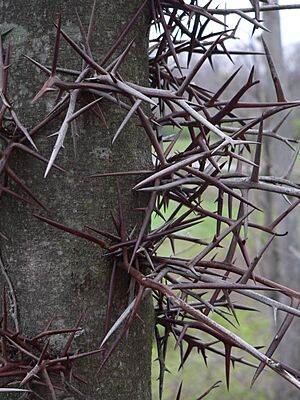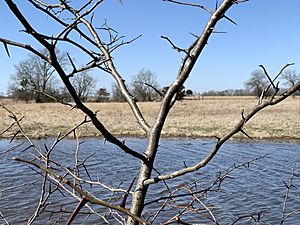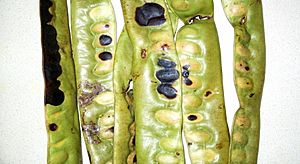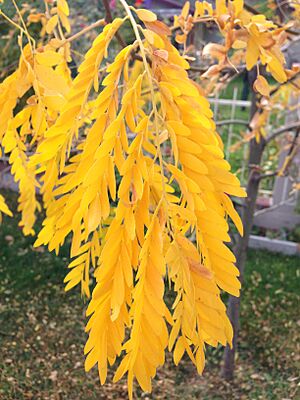Honey locust facts for kids
Quick facts for kids Honey locust |
|
|---|---|
 |
|
| A honey locust in Washington state shows its fall color | |
| Conservation status | |
| Scientific classification | |
| Genus: |
Gleditsia
|
| Species: |
triacanthos
|
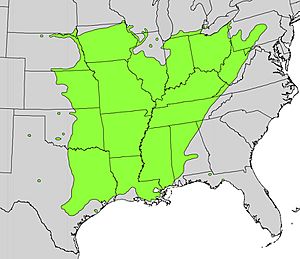 |
|
| Native range. | |
The honey locust (Gleditsia triacanthos) is also known as the thorny locust. It is a deciduous tree that loses its leaves every year. This tree belongs to the pea family (Fabaceae).
Honey locust trees are originally from central North America. They usually grow in wet soil near rivers. These trees can adapt to many different places. They have been planted all over the world. Sometimes, they grow so well that they become an invasive species, meaning they spread quickly and can harm local plants.
Contents
What Does the Honey Locust Look Like?
Honey locust trees can grow very tall, reaching about 20 to 30 meters (65 to 100 feet). They grow quickly and can live for about 120 years.
Their leaves are made of many smaller leaflets. On older trees, the leaves are pinnately compound, meaning leaflets grow along a central stem. On younger, stronger trees, the leaves are bipinnately compound, meaning the leaflets are on smaller stems that branch off the main stem. The small leaflets are about 1.5 to 2.5 centimeters (0.6 to 1 inch) long and are bright green. In autumn, they turn yellow.
Honey locust trees grow their leaves fairly late in the spring. Their cream-colored flowers smell strong and appear in late spring. They grow in groups from where the leaves meet the branches.
The fruit of the honey locust is a flat pod, called a legume. These pods become ripe in early autumn. They are usually about 15 to 20 centimeters (6 to 8 inches) long. Animals like cattle and horses help spread the seeds. They eat the sweet pulp inside the pods and then pass the seeds in their droppings. This helps break down the hard seed coat, making it easier for the seeds to grow. The animal droppings also act as fertilizer for the new seeds.
Honey locust trees often have sharp thorns on their branches. These thorns are usually 3 to 10 centimeters (1 to 4 inches) long. Some can even grow longer than 20 centimeters (8 inches)! The thorns can be single or branched, and they often grow in thick groups. When they are young, the thorns are soft and green. As they get older, they become hard and red, then turn gray and become brittle.
Scientists think these thorns might have helped protect the trees from very large animals that lived long ago, like Pleistocene megafauna. These large animals might have also helped spread the seeds. However, the thorns are not as useful against smaller animals like deer today. Some honey locust trees do not have thorns. These thornless types (called Gleditsia triacanthos var. inermis) can be found in nature and are also grown in nurseries.
How People Use and Grow Honey Locust Trees
Honey locust trees are popular ornamental plants, meaning they are grown for their beauty. They are especially liked in the northern plains of North America, where not many other trees can survive well. These trees are very tough. They can handle city conditions, hard soil, road salt, hot weather, and dry spells. They are also easy to move and replant.
Because they grow fast and can live in poor soil, honey locust trees are good for places where shade is needed quickly. This includes new parks, housing areas, or places where the land has been disturbed, like old mining sites. Some types that grow tall and narrow are great for planting along streets.
Honey locust trees are resistant to gypsy moths. However, another pest called the mimosa webworm can eat their leaves. Some trees can also have problems with spider mites, cankers (tree diseases), and galls (unusual growths). Many of the types grown in gardens do not have thorns.
Honey Locust in Agriculture
In some farming areas, like parts of Australia, the honey locust is considered a major problem plant. It can grow in thick groups, taking over land that livestock need for grazing. These thick groups can also block waterways, making it hard for animals to drink. The thorns can hurt people, farm animals, and wild animals. They can even puncture vehicle tires.
In the Midwest of the United States, honey locust is also seen as a weed tree on farms. Farmers who grow only one type of crop (called monocropping) often find it a nuisance. Its fast growth means it can grow better than grasses and other crops.
Uses of the Honey Locust
Food
The soft pulp inside the honey locust pods can be eaten. Wild animals and livestock enjoy it. It's important to know that the honey locust is safe to eat, unlike the black locust tree, which is poisonous.
Even though it's called "honey locust," this tree is not a main source of honey for bees. The name comes from the sweet taste of the pod's pulp. Native American people used this sweet pulp for food and traditional medicine. It can also be used to make tea.
The long pods eventually dry and turn brown or maroon. They have a tough, leathery skin that sticks tightly to the pulp inside. The pulp is bright green when the pods are unripe. When ripe, it is very sweet, crunchy, and juicy. Inside the pulp, there are dark brown, tannin-rich beans in separate sections.
Timber
Honey locust trees produce strong, good quality wood that can be polished nicely. However, there are not enough honey locust trees to support a large wood industry. Still, there is a special market for honey locust furniture.
Its wood is also used for fence posts and rails because it is dense and resists rotting. In the past, the hard thorns from younger trees were used as nails. The wood itself was used to make wooden pegs, called treenails, for building ships.
Nitrogen Fixation
Scientists are still debating whether the honey locust tree can "fix nitrogen." Nitrogen fixation is a process where plants take nitrogen gas from the air and turn it into a form they can use to grow. Many sources say that honey locusts do not fix nitrogen because they don't form special bumps on their roots called "root nodules" with helpful bacteria. These bacteria usually help with nitrogen fixation.
However, some people, especially in permaculture (a way of designing sustainable human settlements and agricultural systems), believe that honey locusts do fix nitrogen, but in a different way.
Both plants that do and do not form root nodules can grow well in soil that doesn't have much nitrogen. The leaves and seeds of plants that don't form nodules sometimes have more nitrogen than other plants. How this happens is not fully understood yet. Some studies have shown signs of nitrogen fixation in non-nodulating plants, including the honey locust. Scientists have seen small groups of bacteria-like cells inside the roots of honey locusts. These might be an early step in how plants evolved to fix nitrogen. It's not known if this type of nitrogen fixation helps nearby plants, as it does with plants that form root nodules.
Images for kids
See also
 In Spanish: Acacia de tres espinas para niños
In Spanish: Acacia de tres espinas para niños



